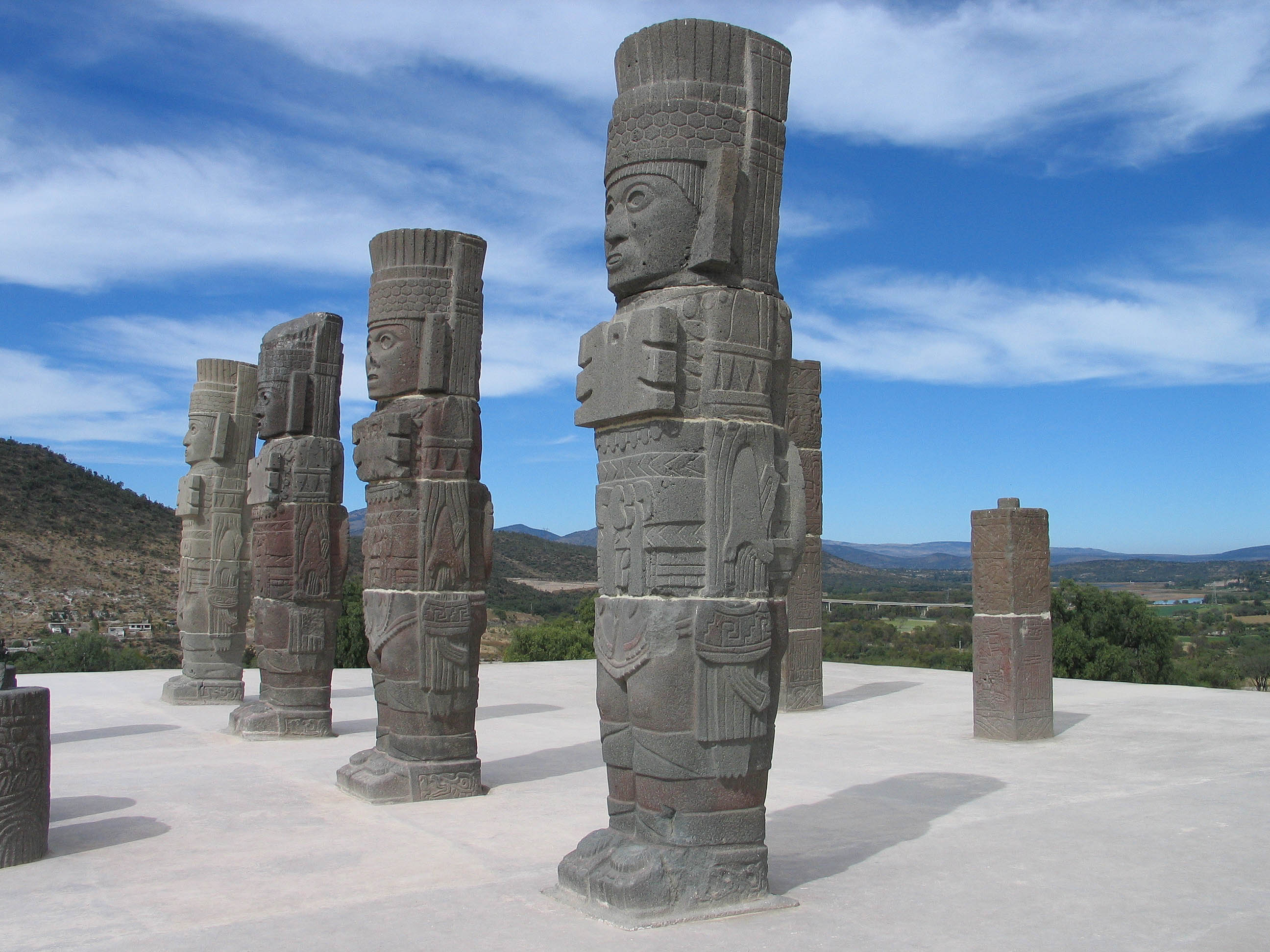All AP Art History Resources
Example Questions
Example Question #11 : Sculpture Beyond European Artistic Traditions
The most well known type of Olmec art is __________.
intricate silver jewelry fashioned in complex shapes with gemstones
large-scale fresco murals depicting massive battle scenes
bas-relief sculptures illustrating the ritualistic Mesoamerican ballgame
colossal basalt sculptures that only depict the head of their subjects
colossal basalt sculptures that only depict the head of their subjects
The Olmec civilization dominated what is now Southern Mexico from roughly 1500 BCE to 400 BCE, laying the groundwork for the later civilizations of the Maya and Aztec. The most familiar and most impressive part of their civilization that has survived are basalt sculptures of heads that weigh between 6 and 50 tons, and which took extraordinary coordination to have the stones moved and sculpted into their proper forms.
Example Question #1 : Sculpture Of The Americas
Arguably the most recognizable piece of artwork from Mesoamerica is the Aztec __________. This stone was carved in the mid-fifteenth century and presents different worlds of the sun according to Aztec mythology. This stone was once a part of the Templo Mayor of Tenochtitlan.
Stucco
Sun Stone
Altar
Throne
None of the other answers is correct.
Sun Stone
The Aztec Sun Stone (also known as the Aztec Calendar Stone) is an elaborately carved stone disk that represents a link between humanity and the divine through the current ruler of the Aztec Empire at the time of its carving. It is not a working calendar. It may also have at some point been anointed with blood sacrifices to please the gods the Aztecs believed in.
Example Question #3 : Sculpture Of The Americas

These stone monuments left behind by the Toltec civilization, which occupied what is now Hidalgo, Mexico, are an example of which type of monument frequently found in Pre-Columbian architecture and sculpture?
Zapotec Guardians
Atlantean figures
Aztec Warriors
Warior Totems
Toltec Guardians
Atlantean figures
Atlantean figures have been found in various different areas of pre-Columbian Mesoamerica, most notably in Hidalgo, Mexico, which was previously occupied by the Toltecs. Their purpose is generally as support pillars. Atlantean refers to the Titan god Atlas, from Ancient Greek mythology, who was doomed to hold up the heavens for all eternity. They are generally carved to represent fierce, bellicose men. When the Aztecs found these pillars after the Toltecs abandoned their city, they imagined that the pillars represented their own gods, and considered the city divine.
Image accessed at: https://commons.wikimedia.org/wiki/File:Telamones_Tula.jpg
Photograph by Luidger
Example Question #1 : Answering Other Questions About Sculpture Of The Americas
Pre-Columbian art refers to the artistic endeavors of the indigenous populations of which areas prior to the mid-sixteenth century?
China
Eastern Europe
Southeast Asia
Russia
North, South and Central America and the Caribbean
North, South and Central America and the Caribbean
The term "Pre-Columbian" refers to a time before European colonization of the Americas. The term can be deconstructed as "Before Columbus," as Christopher Columbus' arrival to the Americas is seen as the beginning of European influence in what was then known as the "new world."
Example Question #5 : Sculpture Of The Americas
Art and architecture from which Mesoamerican civilization is arguably the most well known and studied, its creators having inhabited Mexico during the late postclassic period of the Pre-Columbian era, when the European colonization of the Americas began?
The Olmec
The Toltec
The Inca
The Mayans
The Aztecs
The Aztecs
The Aztecs occupied a large portion of central Mexico and Mesoamerica from the fourteenth to the sixteenth century. They were the last surviving major civilization of the Mesoamerica by the time that Spanish sailors invaded the area. Much is known about their art and culture, as they were (historically-speaking) very recently conquered by Spain. Although Spain did destroy a very large amount of their artwork and culture as part of their takeover of Latin America, much remains, and was later studied.
Example Question #1 : Asian Sculpture
Which is NOT true of the Shiva Nataraja bronze sculptures from the Chola Dynasty?
Shiva is depicted symmetrically.
Shiva has four arms and two legs.
Shiva stomps on apasmara (symbol of illusion).
Shiva is surrounded by a ring of fire.
Shiva makes the "fear not" mudra.
Shiva is depicted symmetrically.
Shiva is depicted asymmetrically. Three hands gesture to his right while one hand gestures to his left. In addition, his left leg is raised to his right while his other leg is rooted firmly to the ground. Shiva's front left hand, which points to his raised left foot, signifies refuge for the troubled soul.
Example Question #11 : Sculpture Beyond European Artistic Traditions

The structure is made out of which of the following materials?
Schist
Diorite
Marble
Clay
Sandstone
Sandstone
Sandstone was one of the most easily obtainable building materials in the region and was often employed in works commissioned by Ashoka.
Image: Great Stupa at Sanchi commissioned by Emperor Ashoka, c. 300 BCE–100 CE. From https://en.wikipedia.org/wiki/Sanchi#/media/File:Sanchi_Stupa_from_Eastern_gate,_Madhya_Pradesh.jpg.
Example Question #171 : Sculpture
Which other architectural element does The Gates bear resemblance to?

Ionic columns
Art deco architectural style
Muqarnas in Islamic architecture
The Great Wall of China
Japanese Torii gates
Japanese Torii gates
The Gates bears a strong resemblance to Japanese Torii gates. They are often found at the entrance to Shinto shrines, and traditionally Japanese businessmen would buy them to pay tribute to the god Inari (the god of prosperity).

Image accessed through Wikipedia Media Commons: https://en.wikipedia.org/wiki/The_Gates#/media/File:FushimiInariTorii.jpg
Image accessed through Wikipedia Media Commons: https://en.wikipedia.org/wiki/The_Gates#/media/File:Gates_a.jpg
Example Question #2 : Asian Sculpture
What is the largest religious monument in the world and what god does it celebrate?
Akshardham, Shiva
Angkor Wat, Vishnu
Angkor Wat, Brahma
Meenajshi Amman Temple, Meenakshi Amma
Akshardham, Nataraja
Angkor Wat, Vishnu
Angkor Wat, meaning City Temple, is the world's largest religious monument. It is located in Siem Reap, Cambodia. It was built for Vishnu, a main Hindu god.
Example Question #3 : Asian Sculpture
In order to be a conqueror in the afterlife, as he was in living life, Qin Shihuang (the First Emperor) built a tomb filled with what?
Terracotta warriors
All of these
Jade jewelry
Mercury
Gold and silver ornaments
All of these
The mausoleum the First Emperor built in the Qin Dynasty was filled with over 7,000 terracotta statues of warriors, horses, and chariots. Archeologists also found jade jewelry and gold and silver ornaments. High levels of mercury were found in the mausoleum and indicate that it ran in troughs all throughout the building.
Certified Tutor
All AP Art History Resources



